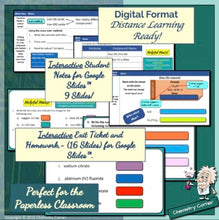Naming & Writing Ionic Formulas (Nomenclature) Part Two: Students will write formulas and name ionic compounds containing multivalent metals (Roman Numerals).
Have you ever experienced teaching your heart out with nomenclature only to end up with students sticking in roman numerals and prefixes everywhere? This lesson is separated from the Part One lesson because I have found that if students master naming and writing formulas of binary and ternary compounds first, without introducing roman numerals, they will have a greater chance of being able to separate the compounds that need roman numerals from those that don’t. So, this lesson is separated from Part One, and focuses on identifying the metals that need roman numerals and why they do. Building on previous knowledge of ions and formulas from Part One are included in the Exit Ticket and the Homework (all types of ionic compounds, mixed.
Note: This is an editable animated PowerPoint. This means that It will appear to be busy and even overlapping in the “slide” mode, but will be awesome in the “slide show” mode. Please don’t edit the product until you have watched it in slide show mode.
Lesson Objectives:
Naming and Writing formulas for ionic compounds that have more than one oxidation state
Also included in this lesson’s student work are:
Naming and Writing Binary Ionic Compounds
Naming and Writing Ternary Ionic Compounds (with Polyatomic Ions)
Naming and Writing Monatomic and Polyatomic Ions
This lesson is appropriate for grades 9-12 chemistry or physical science.
Note: This lesson is included in the following two bundles
Naming and Writing Chemical Formulas MEGA Unit BUNDLE
Naming and Writing Chemical Formulas LESSONS Bundle
Lesson Duration: 1 class period
Included in This Resource:
PowerPoint Presentation – Editable & Animated – 13 slides
Student Notes – Cornell Style Cloze Notes - editable, print, & digital
Student Notes – Blank
Student Notes Suggested KEY
Exit Ticket – Check for Understanding w/ KEY - editable, print, & digital
Homework/Practice w/ KEY - editable, print, & digital
Teacher Notes (2 pages full of some great background info,
Teacher Prep Time: just print and go!
This will be a lesson you will want to use year after year!
Chemistry Corner
***************************************************************************
Check out these other products that you may be interested in:
Naming & Writing Ionic Formulas: Part One
Naming & Writing Chemical Formulas: Acids & Hydrates
Naming & Writing Chemical Formulas: Molecular Compounds
Nomenclature Task Cards
Chemistry Doodle Notes for the Year – A Growing Bundle
High School Chemistry Year Curriculum: A Growing Bundle
***************************************************************************
Become a subcriber to receive updates about new products as we add them.
Chemistry Corner’s PowerPoints are perfect for the flipped classroom. However, please read the Copyright Terms below before using them as such. Thanks!
LICENSING TERMS: By downloading this product, you own a license for one teacher only for personal use in your classroom. Licenses are non-transferable, meaning they cannot be passed from one teacher to another. No part of this resource is to be shared with colleagues or used by an entire grade level, school, or district without purchasing the proper number of licenses. I you are a coach, principal or district interested in transferable licenses to accommodate yearly staff changes, please contact me at beth@chemistrycorner.com.
COPYRIGHT TERMS: ©Chemistry Corner. Please note – all material included in this resource belongs to Chemistry Corner. By downloading, you have a license to use the material, but you do not own the material. This resource, or any portion of this resource, may not be uploaded to the internet in any form, including classroom/personal websites or network drives, unless the site is password protected and can only be accessed by students—no other teachers or anyone else on the internet.








